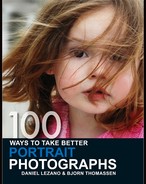36
Use key shifting
An area of lighting control that is not often mentioned but is commonly used by professional portrait and glamour photographers is key shifting. This involves being able to control the amount of light falling on your subject and how this balances with the amount of light illuminating the general scene. While this can be done using only one main source – for example, daylight – it more usually involves working with more than one light source. The most common type of key shifting involves controlling the balance of ambient (daylight) and artificial (flash) light to create a particular effect. Mixing light sources is not particularly easy, but mastering it is vital if you want to develop your photography and potentially shoot professionally.
Key shifting is a basic exposure technique in which you determine the ratio of ambient and flash light. You need to work out whether ambient light is dominant over flash exposure; whether both are perfectly balanced; or whether flash takes priority.
By exposing for one light source, you are giving it priority over the other, and in effect key shifting. The wider the difference in exposure between the two light sources, the greater the key shift. Using this technique allows you to vary how the subject and the environment are recorded in terms of their exposure. With the flash exposure ensuring the subject is well exposed, you can set the ambient exposure to overexpose the backdrop (i.e., lighten it); underexpose (darken) it; or correctly expose it to create a natural-looking result (i.e., treat the flash as fill-in).

HIGH FASHION
Several techniques were employed to make this image as powerful as possible. The composition, strong diagonal lines, low viewpoint and choice of ultra-wide-angle lens all work to create an image with impact. Add to this careful control of ambient and studio flash light and bold colours and you have a very strong fashion portrait. Here’s how key shifting was applied to this scene to give such a bold result: the ratio of flash to ambient light was increased so the amount of flash used was high enough to force down the amount of ambient exposure required. In other words, the scene was correctly exposed for the flash, and, because the flash was at a relatively high setting, the backdrop was effectively underexposed. The result is a correctly exposed subject and a deeply saturated sky (which is effectively grossly underexposed by around three stops). A portable studio flash head with mini-dish provided the flash output. Shooting on a full-frame DSLR allowed for such a wide-angle view.
Canon EOS-1DS, 28–70mm lens at 28mm, 1/250 sec at f/22, ISO 100.
